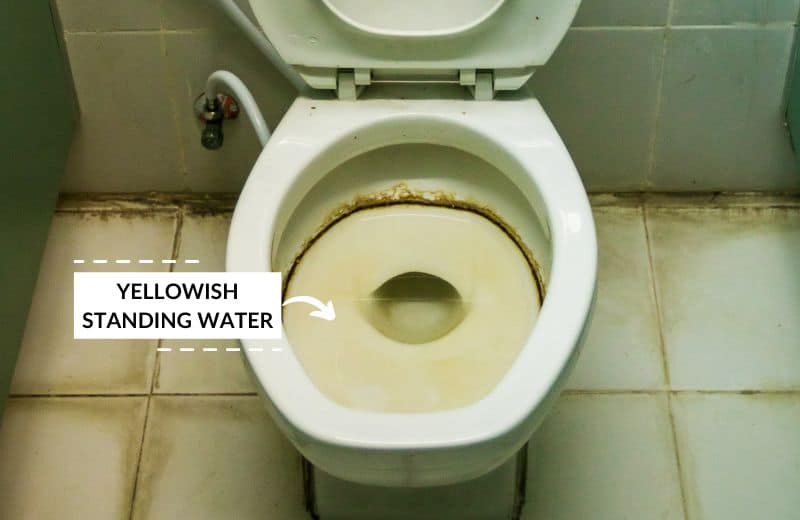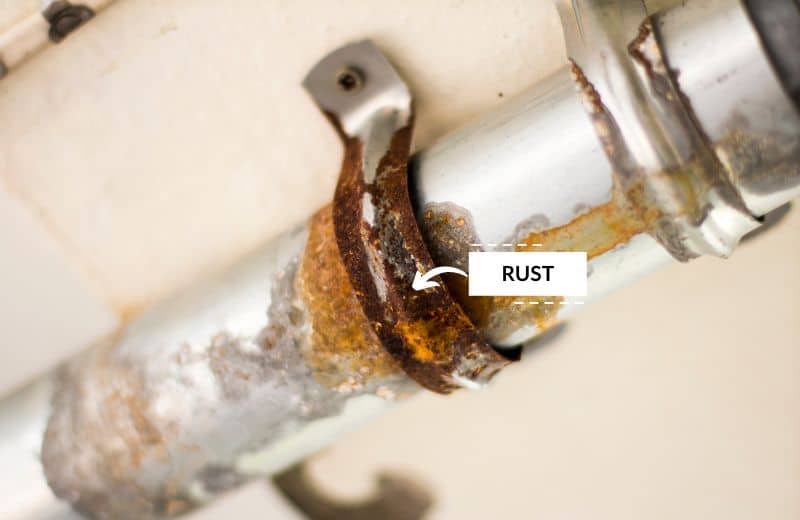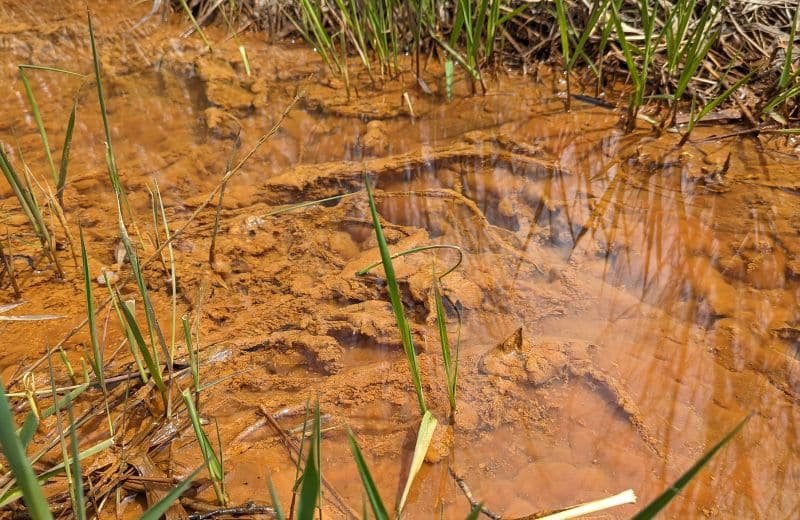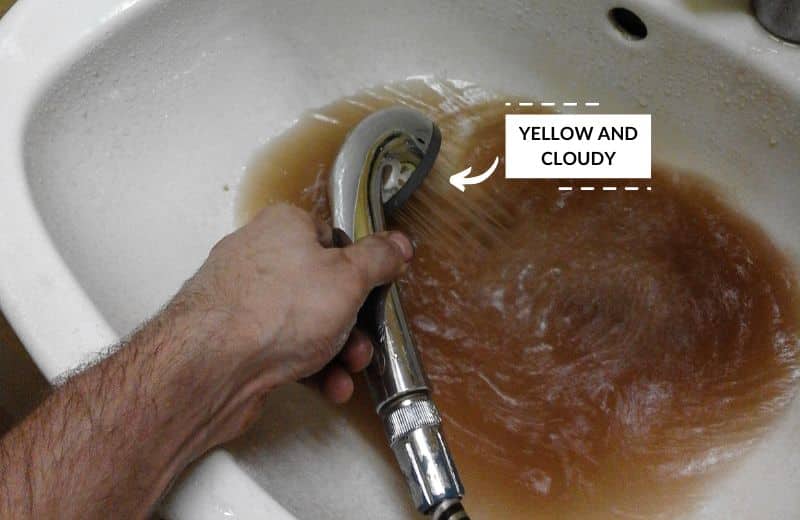Noticed yellow water in your toilet even after flushing? You’re probably keen to get to the bottom of the issue as soon as possible. Not only are yellow stains in your water unsightly, but they can point to a bigger problem that needs to be addressed as soon as possible.
We’ve been researching and testing solutions for poor water quality for over a decade, and we’ve used our own knowledge and data from scientific studies and reports to produce this guide.
Keep reading to learn about the 7 most likely causes of yellow toilet water, and how to fix them.
| Cause | How to Fix |
|---|---|
| Standing gets discolored | Flush the toilet to replace the yellow water with fresh water. If stains remain, clean with bleach. |
| Local repairs dislodges sediment and rust | Flush your faucets and toilet for several minutes after the repairs are finished. |
| Calcium buildup that appear yellow | Install a water softener, or remove stains temporarily with white vinegar. |
| Rust from pipes or toilet | Arrange for a professional plumbing inspection and treatment, or replace rusty parts. If well water is the culprit, install a water treatment system. For stains, use baking soda. |
| Tannins or iron in water | Test your water and install a suitable treatment system, such as an iron filter for iron or an ion exchange system for tannins. |
| Bacteria or algae growth in the toilet tank or bowl | Drain and clean the toilet tank with bleach for algae. Install a cleaning block to prevent future buildup. For iron bacteria or persistent algae problems in well water, shock the well with chlorine or consult a professional. |
| Water contamination | Identify the source of the problem and address it immediately. Stop drinking tap water and have it tested for bacteria. Seek professional help if needed. |

📌 Key Takeaways:
- Common causes of yellow toilet water include calcium buildup, rust in your pipes, tannins or iron in your water, and bacteria or algae growth.
- You can fix yellow toilet water by flushing the toilet multiple times, installing a water filter or a water softener to remove the yellow-staining contaminants, using a toilet bowl cleaner, and replacing rusted toilet parts.
Table of Contents
- 📥 Standing Water Can Get Discolored
- 🔩 Local Repairs Have Introduced Yellow-Causing Particles to the Water
- 🚽 Calcium Buildup May Give Your Toilet Water a Yellow Tinge
- 🚱 Rust From Your Pipes and Toilet May Be Entering Your Toilet Water
- 🍂 Your Water Might Be Contaminated by Tannins or Iron
- 🦠 Your Toilet Could Have Bacteria or Algae Growth
- 🧫 Worst-Case Scenario: Your Water Has Become Contaminated
📥 Standing Water Can Get Discolored
You might notice an unusual yellow tone to your toilet water after returning from a vacation, when your toilet hasn’t been used or flushed for a few days.
Standing water gets discolored because it has a lot of time to interact with dust and other particles in the air. Certain contaminants in the standing water also have more opportunity to oxidize and cause your toilet water to turn yellow or brown.

✅ How to Fix:
Simply flushing the toilet will drain away the yellow water and replace it with fresh, clean water, resolving the issue.
If your toilet bowl still looks discolored after flushing, give it a quick clean with bleach. This should lift any stains and get your toilet looking clean again.
🔩 Local Repairs Have Introduced Yellow-Causing Particles to the Water
Another possible cause of yellow water in your toilet is that your local water company is carrying out maintenance or repairs on your water supply lines.

Repairs and maintenance can cause a temporary increase in sediment, rust, and other contaminants that may have been dislodged from rusted pipes or allowed to enter the water supply. These may color your toilet water yellow, and they may or may not be dangerous (the EPA says contaminated sediments present a human health risk, but not all sediments are contaminated).
In this case, you’ll probably receive a notice from your water supplier explaining that work is being carried out. You may also be issued a boil water notice.
✅ How to Fix:
Once the local repairs have finished, flush your faucets for five minutes, then flush the toilet so it gets filled with a fresh batch of water (you may have to do this several times). This should flush away any contaminants that have turned your toilet water yellow.
🚽 Calcium Buildup May Give Your Toilet Water a Yellow Tinge
Calcium buildup is another likely reason why the water in your toilet tank or bowl appears to be yellow.
Calcium is found in large quantities in hard water. The USGS estimates that 85% of water supplies in the USA are hard, so there’s a good chance that calcium is the culprit of your toilet’s yellow water.
Calcium forms mineral deposits on surfaces, which have a chalky texture and a whiteish-yellow color.
✅ How to Fix:
You can tackle water hardness minerals with a water softener. Water softeners exchange calcium and magnesium ions with sodium ions, softening the water and preventing limescale problems altogether.
If you just want to temporarily get rid of hard water stains in your toilet, add white vinegar to the toilet and let it soak overnight before scrubbing with a toilet brush. Keep in mind that the stains will continue to return until you install a water softener.

🚱 Rust From Your Pipes and Toilet May Be Entering Your Toilet Water
Rusty water pipes in your home may be leaching floating orange particles into your toilet water, giving it an orange, yellow, or brown tinge.
Rust is especially likely if you have high-pressure water flowing through old pipes that haven’t been replaced in decades, or your pipes are made from materials that are more prone to corrosion, such as iron.

How to Fix:
There are two solutions to preventing yellow or brown water in your toilet caused by rusted pipes:
- Arrange for your plumbing system to be professionally inspected and treated to flush out the rust particles.
- Replace the old or damaged section of your plumbing, or rusty bolts, corroded tank bolts, or rusted toilet pipes, to remove the source of the rust leaching.
Option 1 is the better choice for folks who don’t want to pay to replace their plumbing, but if your pipes are very badly rusted, you might have no choice but to go for option 2.
Sometimes, your water supply might be responsible for corroding your plumbing. Well water sometimes has a low pH and provides an excess of hydrogen irons, which accelerate corrosion. The WQA recommends installing a water treatment system, like a limestone chip or soda ash system, to improve corrosion issues caused by your water supply.
Just want to remove the rust stains from your toilet? Sprinkle baking soda into your toilet water and scrub around the toilet with a brush. The baking soda should lift the tough stains.
🍂 Your Water Might Be Contaminated by Tannins or Iron
Tannins are natural organic matter and are most commonly found in well water supplies. They give water a musty odor and a yellow-orange tea-like color.
If your toilet water is dark yellow and has a musty smell, your water might contain tannins.
Iron is also commonly found in well water. When groundwater flows through layers of rock and soil on its journey to the well aquifer, it picks up tiny iron particles.
Iron may be dissolved in water, meaning that it doesn’t change the appearance of water. But the iron particles will oxidize and stain surfaces when the water comes into contact with the air.
If you notice orangey-brown water in your toilet and your tap water has a metallic taste, you might have iron in your water.
✅ How to Fix:
If you think the yellow water in your toilet is caused by iron or tannins in your water, the best solution is to remove these contaminants from your water as soon as they enter your plumbing.
First, test your water to confirm your suspicions. Test for iron, tannins, and any other contaminants that you think might be to blame.
Once you’ve got your results, determine a suitable water treatment solution:
- For iron, install an iron filter, like an air injection/oxidation system
- For tannins, use an ion exchange system, aeration, chemical treatment, or activated carbon for low levels
Regardless of the filtration system you choose, make sure to install it at your main water line’s point of entry into your home. This will protect your entire plumbing system from yellow-causing impurities.
Related: Why is my well water yellow?
🦠 Your Toilet Could Have Bacteria or Algae Growth
Finally, bacteria or algae growth in your toilet could be to blame for yellow stains.
You’re unlikely to find bacteria or algae in municipal water, but well water supplies may contain these contaminants.
Certain types of algae are yellowish-green, with a slimy texture. Algae growth is most common in the toilet tank.
Bacteria is invisible in water – unless it combines with iron to form iron bacteria. You may notice slimy, clumpy reddish-yellow deposits in your toilet cistern or toilet bowl, or floating iron bacteria in water that looks like “orange snot” (lovely, we know).

✅ How to Fix:
To remove algae from your toilet, drain the water from the cistern and use bleach to deep-clean your toilet tank. For stubborn buildup, leave the bleach to sit for up to an hour before scrubbing it away.
You can help to prevent microbes from accumulating in your toilet by installing a cleaning block on your toilet rim.
But if iron bacteria or algae is an ongoing problem in your well, you will need to tackle the cause of the issue. For iron bacteria, the WQA recommends shocking your well with chlorine, or you might need to get your well inspected by a professional contractor.
🧫 Worst-Case Scenario: Your Water Has Become Contaminated
In a worst-case scenario, yellow, discolored toilet water might be the result of contamination of your water supply.
There are a few possible causes of contaminated water in your home, including a leaking pipe, a damaged or compromised well, and a faulty sewage pipe.
Well water supplies are most at risk of contamination, but the CDC says that even public drinking water supplies can sometimes get contaminated.
If your toilet water is contaminated and it’s on the same plumbing system as your faucets, you’ll notice the same discoloration in the water supplied around your home. Contaminated water is dangerous and may pose a health risk, depending on the contaminants present, so act fast if you suspect this problem.

✅ How to Fix:
To fix a water contamination issue, you’ll need to identify the source of the problem as soon as possible.
If the problem is relatively small, you might be able to sort it temporarily yourself. For instance, if an inspection of your pipes brings you to a small leak, patch it up with tape while you schedule an inspection by a professional plumber.
You should stop drinking your tap water and test it for bacteria if you have any reason to suspect that it has been contaminated.

